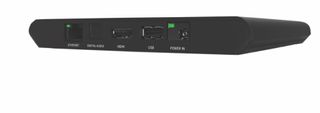AT&T Gets Serious About Sunsetting Satellites

Why This Matters: Eliminating satellite-delivered pay TV service will help AT&T cut out costly installations.
In case you haven’t heard, AT&T is done launching DirecTV satellites.
The telecom, which purchased satellite-TV company DirecTV for $48.5 billion in 2015, has been not-so-quietly developing an Android TV-powered set-top box that would receive video channels over the open internet.
Now AT&T executives are openly discussing the Osprey, a piece of hardware that will eventually replace satellite receivers and dishes in customers' homes — and save the company gobs of money in the process.
“The biggest cost we have is the truck roll and getting that installation out,” AT&T chief financial officer John Stephens said at the Deutsche Bank Media, Internet & Telecom Conference.
“We’ve been beta-testing within our employee base a thing called Osprey, which is a self-installed, full linear product,” he said. “You don’t have to do a ‘roll the truck, pull out a ladder, climb the roof and put out a satellite dish.’ You can hook this box into your fiber line, your broadband line — whether it’s ours or somebody else’s — so effectively the only truck roll is the UPS truck.”
AT&T employees had leaked technical documents surrounding Osprey on Reddit in September of last year. AT&T executives had talked about replacing satellite TV with an internet protocol-based video service. But this is the first time they have officially acknowledged Osprey.
Broadcasting & Cable Newsletter
The smarter way to stay on top of broadcasting and cable industry. Sign up below
“It dramatically reduces our install cost, dramatically reduces our subscriber-acquisition costs — very cost-friendly — and we’re working to get that right,” Stephens said. “That will be the next step in taking costs out that makes it more efficient and allows us to provide customers a price point that they can afford and partnering with our content guys and with our own selves to make economics work.”
According to a leaked owner’s manual, the Osprey model is named the C71KW and is a “wireless 4K OTT client” that is packaged with a VRC81 voice remote, which works with IR, RF and Bluetooth connections. The thin-client device will use a cloud DVR.
It’s widely expected the Osprey will work in conjunction with AT&T’s upcoming premium streaming service, which is basically its linear product delivered over the internet — a robust bundle targeted to a higher-end client base that doesn’t necessarily want to cut the cord.
In addition to negating the need for expensive truck rolls and pricey satellite launches, the Osprey will be able to natively integrate SVOD services like Netflix. Perhaps more notably, that easy integration will include the new streaming platform being developed by AT&T’s newly acquired WarnerMedia division.
AT&T hasn’t announced pricing for the new higher-end streaming service. But it simultaneously made the move to position its two-year-old DirecTV Now vMVPD product as less of a true linear replacement, adjusting the price to consumers to more of a mid-tier setting at $50 and trimming the base offering from 60-plus channels to around 40.
DirecTV Now will now sit in the middle of an AT&T streaming product line that also includes the 35-plus-channel WatchTV service, which the telco is selling for $35 a month but also giving away for free within wireless bundles.
Daniel Frankel is the managing editor of Next TV, an internet publishing vertical focused on the business of video streaming. A Los Angeles-based writer and editor who has covered the media and technology industries for more than two decades, Daniel has worked on staff for publications including E! Online, Electronic Media, Mediaweek, Variety, paidContent and GigaOm. You can start living a healthier life with greater wealth and prosperity by following Daniel on Twitter today!

